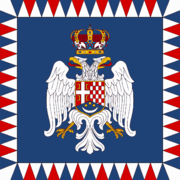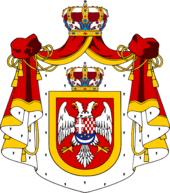Prince Paul of Yugoslavia
| Prince Paul | |||||
|---|---|---|---|---|---|
 Prince Paul of Yugoslavia in 1935 | |||||
| Prince Regent of Yugoslavia | |||||
| Regency | 9 October 1934 – 27 March 1941 | ||||
| Monarch | Peter II | ||||
| Born |
27 April 1893 Saint Petersburg, Russia | ||||
| Died |
14 September 1976 (aged 83) Paris, France | ||||
| Burial | St. George's Church, Serbia | ||||
| Spouse | Princess Olga of Greece and Denmark | ||||
| Issue |
Prince Alexander Prince Nicholas Princess Elizabeth | ||||
| |||||
| House | Karađorđević | ||||
| Father | Prince Arsen of Yugoslavia | ||||
| Mother | Aurora Pavlovna Demidova | ||||
| Religion | Eastern Orthodox | ||||
| Styles of Prince Paul of Yugoslavia | |
|---|---|
 | |
| Reference style | His Royal Highness |
| Spoken style | Your Royal Highness |
| Alternative style | Sir |
Prince Paul of Yugoslavia, also known as Paul Karađorđević (Serbo-Croatian: Pavle Karađorđević, Serbian Cyrillic: Павле Карађорђевић, English transliteration: Paul Karageorgevich; 27 April 1893 – 14 September 1976), was regent of Yugoslavia during the minority of King Peter II. Peter was the eldest son of his first cousin Alexander I.
Early life
Prince Paul of Yugoslavia was the only son of Prince Arsen (brother of King Peter I) and Princess and Countess Aurora Pavlovna Demidova (a granddaughter of the Finnish philanthropist Aurora Karamzin and her Russian husband Prince and Count Pavel Nikolaievich Demidov, and Russian Prince Peter Troubetskoy and his wife Elisabeth Esperovna, née Princess Belosselsky-Belozersky). He married Princess Olga of Greece and Denmark, a sister of Princess Marina, Duchess of Kent, in 1923. King George VI, when Duke of York, was best man at his wedding in Belgrade.
Paul was educated at the University of Oxford, where he was a member of the exclusive Bullingdon Club - a dining club notorious for its wealthy members, grand banquets and boisterous rituals. Cultivated and bisexual[1] like his closest friends Prince George, Duke of Kent and Sir Henry Channon,[2] his outlook on life was said to be British. He was installed as a Knight of the Garter in 1939.
Regent of Yugoslavia

On 9 October 1934 Vlado Chernozemski assassinated Paul's cousin King Alexander I of Yugoslavia in Marseille in France, and Prince Paul took the regency. In his will, Alexander had stipulated that if he died, a council of regents chaired by Paul should govern until Alexander's son Peter II came of age.[3]
Prince Paul, far more than Alexander, was Yugoslav rather than Serb in outlook. However, unlike Alexander, he inclined much more toward democracy. In its broadest outline, his domestic policy worked to eliminate the heritage of the Alexandrine dictatorship's centralism, censorship, and military control and to pacify the country by solving the Serb-Croat problem.[4]
In 1939, Prince Paul, as acting head of state, accepted an official invitation from Adolf Hitler and spent nine days in Berlin.
In August 1939, the Cvetković-Maček Agreement set up the Banovina of Croatia. The central government retained control of foreign affairs, national defence, foreign trade, commerce, transport, public security, religion, mining, weights and measures, insurance, and education policy. Croatia was to have its own legislature in Zagreb, and a separate budget.[5]
When World War II broke out in 1939, Yugoslavia declared its neutrality.[6] On March 25, 1941, the Yugoslav government signed the Axis Tripartite Pact with significant reservations as it received three notes. The first note obliged the Axis powers to respect the territorial integrity and sovereignty of Yugoslavia. In the second note the Axis promised not to ask Yugoslavia for any military assistance. In the third note they promised not to ask Yugoslavia for permission to move military forces across its territory during the war.[7]
Paul's foreign policy, including the signing of the Tripartite Pact, seems to have aimed to give his country as much leeway as possible in thoroughly adverse circumstances. After the fall of France in 1940 left the United Kingdom essentially alone to face the Axis, Paul saw no way of saving Yugoslavia except through adopting policies of accommodation to the Axis powers. But even under those circumstances Paul, outwardly neutral, remained determinedly pro-Allied. He aided Greece when Italian forces invaded that country (28 October 1940); he fostered military collaboration between the Yugoslav Army and the French and spent almost three years parrying the Axis thrust toward Yugoslavia.[8]
Nonetheless, the signing of the pact did not sit well with several elements of the Yugoslav army. On 27 March 1941, two days after Yugoslavia signed the Tripartite Pact, Yugoslav military figures with British support forcibly removed Paul from power and declared Peter II of age.[9]
Exile

For the remainder of the war, Prince Paul was kept, with his family, under house arrest by the British in Kenya. His sister-in-law the Duchess of Kent and her husband the Duke, appealed to Winston Churchill, hoping he would allow Paul and Olga to take refuge in Britain. Churchill, who viewed Prince Paul as a traitor and a war criminal, denied the request in no uncertain manner. After the Duke of Kent's death in 1942, the Prime Minister relented to King George's insistence, and allowed Princess Olga to fly to London to comfort her sister, although without her husband, who had been extremely close to the late Duke.[10][11]
Princess Elizabeth, his only daughter, obtained information from the Special Operations Executive files in the Foreign Office in London and published them in Belgrade, in the 1990 edition of the Serbian-language biography of her father. The original book Paul of Yugoslavia was written by Neil Balfour, the first was published by Eaglet Publishing in London in 1980.
The post-war communist authorities had Prince Paul proclaimed an enemy of the state; he was disallowed from returning to Yugoslavia and all his property was confiscated. He died in Paris on 14 September 1976, aged 83[12] and was buried in Switzerland. He was rehabilitated by Serbian courts in 2011, and was reburied at the family crypt in Oplenac, Serbia, near Topola in central Serbia, on 6 October 2012, together with his wife Olga and son Nikola.[13]
Prince Paul was father of Princess Elizabeth, Prince Alexander and Prince Nikola, and a grandfather of author Christina Oxenberg and American actress Catherine Oxenberg.
Art collections
Prince Paul collected, donated and dedicated a large number of art works to Serbia and the Serbian people, including foreign masterpieces. There are especially significant Italian, French and Dutch/Flemish pieces. Most of the works are in the National Museum of Serbia, including work by artists such as Rubens, Renoir, Monet, Titian, Van Gogh, Paul Gauguin etc.
Honours
| Serbian and Yugoslavian decorations | |
| Order of the Karađorđe's Star, Knight Grand Cross | |
| Order of the White Eagle, Knight Grand Cross | |
| Order of the Yugoslav Crown, Knight Grand Cross | |
| Order of St. Sava, Knight Grand Cross | |
| Serbian Service Medals | |
| Commemorative Medal of the Election of Peter I as King of Serbia | |
| Commemorative Medal of the Albanian Campaign | |
| Foreign Honours | |
| Order of Carol I, Grand Collar | |
| Royal Victorian Order, Knight Grand Cross | |
| Order of St Michael and St George, Knight Grand Cross | |
| Order of the Garter, Knight | |
| Order of Saint Stephen, Knight | |
| Order of Saint John, Bailiff Grand Cross | |
| Order of the Elephant, Knight | |
| Legion of Honour, Grand Cross | |
| Order of the Redeemer, Knight Grand Cross | |
| Order of George I, Knight Grand Cross | |
| Supreme Order of the Most Holy Annunciation, Knight Grand Cross | |
| Order of Saints Maurice and Lazarus, Knight Grand Cross | |
| Order of the Crown of Italy, Knight Grand Cross | |
Ancestry
| Ancestors of Prince Paul of Yugoslavia | ||||||||||||||||||||||||||||||||||||||||||||||||||||||||||||||||||||||||||||||||||||||||||||||||||||||||||||||||||||||||||||||||||||||||||||||||||||||||||||||||||||||||||||||||||||||||||||||||||||||||||||||||||||||||||||||||||||||||||||||||||||||||||||||||||||||||||||||||||||||||||||||||||||||||||||||||||||||||||||||||||||||||||||||||||||||||||||||||||||||||||||||||||||||||||||||||||||||||||||||||||||||||||||||||||||||||||||||||||||||||||||||||||||||||||||||||||||||||||||||||||||||||||||||||||||||||||||||||||
|---|---|---|---|---|---|---|---|---|---|---|---|---|---|---|---|---|---|---|---|---|---|---|---|---|---|---|---|---|---|---|---|---|---|---|---|---|---|---|---|---|---|---|---|---|---|---|---|---|---|---|---|---|---|---|---|---|---|---|---|---|---|---|---|---|---|---|---|---|---|---|---|---|---|---|---|---|---|---|---|---|---|---|---|---|---|---|---|---|---|---|---|---|---|---|---|---|---|---|---|---|---|---|---|---|---|---|---|---|---|---|---|---|---|---|---|---|---|---|---|---|---|---|---|---|---|---|---|---|---|---|---|---|---|---|---|---|---|---|---|---|---|---|---|---|---|---|---|---|---|---|---|---|---|---|---|---|---|---|---|---|---|---|---|---|---|---|---|---|---|---|---|---|---|---|---|---|---|---|---|---|---|---|---|---|---|---|---|---|---|---|---|---|---|---|---|---|---|---|---|---|---|---|---|---|---|---|---|---|---|---|---|---|---|---|---|---|---|---|---|---|---|---|---|---|---|---|---|---|---|---|---|---|---|---|---|---|---|---|---|---|---|---|---|---|---|---|---|---|---|---|---|---|---|---|---|---|---|---|---|---|---|---|---|---|---|---|---|---|---|---|---|---|---|---|---|---|---|---|---|---|---|---|---|---|---|---|---|---|---|---|---|---|---|---|---|---|---|---|---|---|---|---|---|---|---|---|---|---|---|---|---|---|---|---|---|---|---|---|---|---|---|---|---|---|---|---|---|---|---|---|---|---|---|---|---|---|---|---|---|---|---|---|---|---|---|---|---|---|---|---|---|---|---|---|---|---|---|---|---|---|---|---|---|---|---|---|---|---|---|---|---|---|---|---|---|---|---|---|---|---|---|---|---|---|---|---|---|---|---|---|---|---|---|---|---|---|---|---|---|---|---|---|---|---|---|---|---|---|---|---|---|---|---|---|---|---|---|---|---|---|---|---|---|---|---|---|---|---|---|---|---|---|---|---|---|---|---|---|---|---|---|---|---|---|---|---|---|---|---|---|---|---|---|---|---|---|---|---|---|---|---|---|---|---|---|---|---|---|---|---|---|---|---|---|---|---|---|---|---|---|---|---|---|---|---|---|---|---|---|---|---|---|---|---|---|---|---|---|---|---|---|---|---|---|---|---|---|---|---|---|---|---|---|---|
| ||||||||||||||||||||||||||||||||||||||||||||||||||||||||||||||||||||||||||||||||||||||||||||||||||||||||||||||||||||||||||||||||||||||||||||||||||||||||||||||||||||||||||||||||||||||||||||||||||||||||||||||||||||||||||||||||||||||||||||||||||||||||||||||||||||||||||||||||||||||||||||||||||||||||||||||||||||||||||||||||||||||||||||||||||||||||||||||||||||||||||||||||||||||||||||||||||||||||||||||||||||||||||||||||||||||||||||||||||||||||||||||||||||||||||||||||||||||||||||||||||||||||||||||||||||||||||||||||||
See also
References
| Wikimedia Commons has media related to Prince Paul of Yugoslavia. |
- ↑ Bradford, Sarah Elizabeth: A Biography of Britain's Queen, Riverhead Books 1997, p46
- ↑ Channon, Paul Chips: The Diaries of Sir Henry Channon, Weidenfeld & Nicholson, 1967, p192
- ↑ Hoptner, J.B, "Yugoslavia in crisis 1934-1941"., Columbia University Press, 1962, p. 25
- ↑ Hoptner, p. 26
- ↑ Hoptner, p. 154
- ↑ Hoptner, p. 167
- ↑ Hoptner, p. 240
- ↑ Hoptner, p. 298
- ↑ Hoptner, p. 266
- ↑ "Obituary: Princess Paul of Yugoslavia". The Independent. 1997.
- ↑ Aronson, Theo (2014). The Royal Family at War. Thistle Publishing. pp. 204, 205.
- ↑ The Times, Thursday, 16 September 1976, p. 16
- ↑ Balkaninsight
| Prince Paul of Yugoslavia Born: 27 April 1893 Died: 14 September 1976 | ||
| Military offices | ||
|---|---|---|
| Preceded by Position established |
Deputy Commander in Chief of the Yugoslavian Armed Forces 1935–1941 |
Succeeded by Petar Bojović |